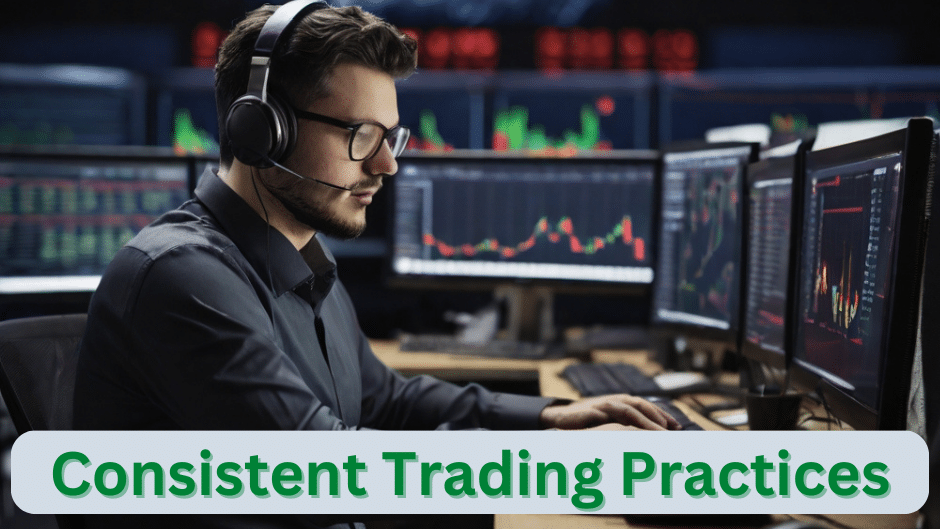Mastering the Markets: Deepening Success Strategic Mentorship and Consistent Trading Practices

Summary
In this episode about Mastering the Markets, Casey Stubbs discusses the importance of consistency in trading. He starts by recapping the previous episode on the benefits of having a mentor.
Casey then explains the five key benefits of consistency and how to achieve them. He emphasizes that consistency improves skills, helps with risk management, builds discipline, enhances performance tracking, and leads to long-term growth and success.
Casey provides tips for achieving consistent trading practices, such as setting specific goals, being accountable, and making small, sustainable changes. He also highlights the importance of building good personal habits for trading success.
Takeaways from Mastering the Markets
- Consistency is crucial for improving trading skills and achieving success.
- Being consistent helps with risk management and avoids impulsive emotional decisions.
- Consistency builds discipline and enhances performance tracking.
- Long-term growth and success in trading are possible through consistency.
- Tips for achieving consistency include setting specific goals, being accountable, and making small, sustainable changes.
- Building good personal habits is essential for trading success.
Overview
Mastering The Markets

Mastering the markets encompasses various aspects of successful trading and can be interpreted in different ways depending on individual perspectives and goals.
Here are some key aspects:
Deep understanding: Possessing a thorough grasp of market dynamics, including technical analysis, fundamental analysis, historical trends, and market psychology.
This understanding allows you to make informed decisions and identify high-probability trading opportunities.
Adaptability and strategy: the ability to adjust your approach based on changing market conditions and develop effective trading strategies tailored to your risk tolerance and goals.
Being adaptable ensures you don’t get caught clinging to outdated strategies in a dynamic market.
Discipline and risk management: Maintaining emotional control, adhering to your trading plan, and implementing well-defined risk management practices to protect your capital.
Discipline prevents impulsive decisions driven by emotions, while risk management ensures you survive even when mistakes occur.
Longevity and consistency: Achieving sustained success over time, avoiding excessive risk-taking, and demonstrating the ability to navigate market ups and downs.
This demonstrates a deep understanding of the market and the ability to weather its storms.
Impact and influence: Going beyond personal gain and contributing to the understanding of markets through innovative strategies or insightful commentary.
This represents the highest level of mastery, where you share your knowledge and experience to benefit others.
Important to remember:
- Mastering the markets is a never-ending journey. Even the most successful traders face setbacks and have bad days.
- Aim for continuous learning, refining your skills, and adapting to changing market realities.
- There’s no “one size fits all” approach. Develop your style and understanding based on your goals and risk tolerance.
Instead of fixating on a mythical state of absolute mastery, focus on acquiring knowledge, developing sound trading practices, and continuously improving your approach.
This mindset sets you on a path of lifelong learning and growth in the ever-evolving world of finance.
Strategic Mentorship

Strategic mentorship offers several key benefits compared to traditional mentorship, making it especially valuable in various contexts.
Here are some key reasons why strategic mentorship is important:
Focus on specific goals: Strategic mentorship involves clearly defined goals and objectives aligned with your career aspirations or organizational needs.
This targeted approach ensures the mentor provides guidance and support tailored to your specific challenges and desired outcomes.
Enhanced career development: A strategic mentor with relevant experience and industry knowledge can offer valuable insights and advice on navigating career paths, developing skills, and building effective networks.
They can connect you with opportunities and help you make informed decisions about your professional growth.
Improved organizational performance: In organizational settings, strategic mentorship fosters knowledge transfer and skill development within teams, leading to improved performance and innovation.
It also promotes talent retention and engagement by providing employees with personalized support and growth opportunities.
Structured approach: Strategic mentorship programs typically follow a structured framework with regular meetings, progress assessments, and feedback mechanisms.
This structured approach ensures accountability and maximizes the effectiveness of the mentoring relationship.
Greater impact: Mentors in strategic programs often provide career coaching and strategic guidance. This combination can have a more significant impact on your professional development and career trajectory compared to traditional mentorship, which might focus solely on general advice and support.
Examples of specific situations where strategic mentorship is valuable are:
- Early-career professionals seek guidance on career paths and skill development.
- Individuals transitioning into new roles or industries.
- Organizations aim to upskill their workforce and enhance innovation.
- Entrepreneurs seek mentorship from experienced business leaders.
Overall, strategic mentorship provides a targeted and structured approach to achieving specific goals and maximizing the benefits of a mentoring relationship.
It’s a valuable tool for personal and professional development, offering greater impact and support compared to traditional mentoring models.
Consistent Trading Practices

Consistent trading practices refer to a set of structured habits and guidelines that a trader adheres to when entering and exiting positions in the market.
By adopting a disciplined approach, traders can minimize emotional biases, effectively manage risk, and enhance their overall decision-making. This structured framework provides clarity and predictability, allowing traders to react quickly to market opportunities and make informed choices based on their predetermined strategy.
These practices are designed to remove emotion from trading decisions, manage risk effectively, consistent practices foster continuous learning and adaptation, and improve overall performance over time.
Here are some key elements of consistent trading practices:
Pre-Defined Trading Strategy:
- Having a clearly defined trading strategy: This outlines your preferred trading style (e.g. day trading, swing trading, long-term investing), specific entry and exit criteria based on technical and fundamental analysis, and risk management rules.
- Backtesting your strategy: Applying your strategy to historical data to evaluate its effectiveness and identify areas for improvement.
- Regularly reviewing and updating your strategy: Adapt your strategy as needed based on changing market conditions, personal goals, and performance analysis.
Disciplined Approach:
- Sticking to your trading plan: Executing trades according to your predetermined strategy, even when facing market volatility or emotional triggers.
- Avoiding impulsive decisions: Resisting the urge to deviate from your plan based on emotions like fear or greed.
- Maintaining emotional control: Staying calm and objective during both winning and losing trades.
Risk Management:
- Setting stop-loss orders: Pre-defined orders that automatically sell your position if the price goes against you, limiting potential losses.
- Proper position sizing: Allocating a specific percentage of your capital to each trade, ensuring you don’t risk too much on any single position.
- Diversifying your portfolio: Spread your investments across different asset classes and markets to mitigate overall risk.
Record-Keeping and Analysis:
- Tracking your trades: Maintaining detailed records of each trade, including entry and exit prices, reasons for entering and exiting, and any observations made.
- Analyzing your performance: Regularly reviewing your trades to identify strengths, weaknesses, and areas for improvement.
- Learning from your mistakes: Reflecting on past losses to avoid repeating them in the future.
Staying Informed:
- Keeping up with market news and trends: Read financial news, research reports, and market commentaries to stay updated on current events and potential opportunities.
- Conducting ongoing research: means continuously learning and acquiring new knowledge about your chosen markets and trading strategies.
- Seeking feedback and advice: Discuss your trading with experienced traders or mentors to gain different perspectives and insights.
Remember:
- Consistency doesn’t mean blindly sticking to the same approach, regardless of market conditions. Adaptability and continuous learning are crucial.
- There is no “one size fits all” approach. Develop practices that align with your risk tolerance, trading style, and goals.
- Even with consistent practices, losses are inevitable. The goal is to minimize losses and maximize gains over time.
By implementing consistent trading practices, you can develop a more disciplined and structured approach to the markets, potentially leading to improved performance and achieving your financial objectives.
Conclusions
Consistent trading practices provide a framework for making sound trading decisions and managing risk effectively. By adhering to a well-defined strategy, traders can avoid impulsive decisions driven by emotions and limit potential losses.
This discipline is essential for long-term success in the markets.
Strategic mentorship can accelerate a trader’s learning curve and help them avoid common pitfalls. Experienced mentors can share their knowledge and insights, providing a fresh perspective on market dynamics and trading strategies.
They can also offer guidance and support as traders navigate the challenges of the market.
Mastering the market requires a deep understanding of market fundamentals, technical analysis, and behavioral economics. This knowledge allows traders to identify patterns, anticipate market movements, and make informed decisions.
As traders gain experience and expertise, their ability to make accurate predictions and execute profitable trades improves.
While achieving absolute mastery in the markets is a continuous pursuit, consistent trading practices, strategic mentorship, and market mastery are essential ingredients for long-term success.
By embracing these principles, traders can position themselves for sustainable profitability in the dynamic and ever-evolving world of finance.
Discover other interesting episodes where you´ll learn a lot about trading from the best. How To Trade It podcast is a win-win for you. Check it out here.
Boost your trading knowledge with these other articles.
Mastering the High-Risk, High-Reward 0DTE Trading Strategy
Best Candlestick PDF Guide – 3 Simple Steps
Connect with Casey:
- Website: https://caseystubbs.com
- YouTube: https://www.youtube.com/TradingStrategyGuides
- YouTube: https://www.youtube.com/caseystubbs
- Facebook: https://www.facebook.com/TradingStrategy
- LinkedIn: https://www.linkedin.com/in/caseystubbs
- Twitter: https://twitter.com/caseystubbs
- TradingStrategyGuides.com: https://www.tradingstrategyguides.com/
- Global Prop Trader: https://globalproptrader.com/
- Email: podcast@tradingstrategyguides.com






